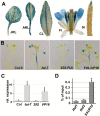FRUITFULL controls SAUR10 expression and regulates Arabidopsis growth and architecture
- PMID: 28586421
- PMCID: PMC5853401
- DOI: 10.1093/jxb/erx184
FRUITFULL controls SAUR10 expression and regulates Arabidopsis growth and architecture
Abstract
MADS-domain transcription factors are well known for their roles in plant development and regulate sets of downstream genes that have been uncovered by high-throughput analyses. A considerable number of these targets are predicted to function in hormone responses or responses to environmental stimuli, suggesting that there is a close link between developmental and environmental regulators of plant growth and development. Here, we show that the Arabidopsis MADS-domain factor FRUITFULL (FUL) executes several functions in addition to its noted role in fruit development. Among the direct targets of FUL, we identified SMALL AUXIN UPREGULATED RNA 10 (SAUR10), a growth regulator that is highly induced by a combination of auxin and brassinosteroids and in response to reduced R:FR light. Interestingly, we discovered that SAUR10 is repressed by FUL in stems and inflorescence branches. SAUR10 is specifically expressed at the abaxial side of these branches and this localized activity is influenced by hormones, light conditions and by FUL, which has an effect on branch angle. Furthermore, we identified a number of other genes involved in hormone pathways and light signalling as direct targets of FUL in the stem, demonstrating a connection between developmentally and environmentally regulated growth programs.
Keywords: Architecture; FRUITFULL; MADS-box transcription factor; SAUR; auxin; branching; growth; hormones; light response.
© The Author 2017. Published by Oxford University Press on behalf of the Society for Experimental Biology.
Figures






Similar articles
-
Divergent regulation of Arabidopsis SAUR genes: a focus on the SAUR10-clade.BMC Plant Biol. 2017 Dec 19;17(1):245. doi: 10.1186/s12870-017-1210-4. BMC Plant Biol. 2017. PMID: 29258424 Free PMC article.
-
microRNA regulation of fruit growth.Nat Plants. 2015 Mar 30;1(4):15036. doi: 10.1038/nplants.2015.36. Nat Plants. 2015. PMID: 27247036
-
[Regulation pattern of the FRUITFULL (FUL) gene of Arabidopsis thaliana].Sheng Wu Gong Cheng Xue Bao. 2010 Nov;26(11):1546-54. Sheng Wu Gong Cheng Xue Bao. 2010. PMID: 21284215 Chinese.
-
Make hay when the sun shines: the role of MADS-box genes in temperature-dependant seasonal flowering responses.Plant Sci. 2011 Mar;180(3):447-53. doi: 10.1016/j.plantsci.2010.12.001. Epub 2010 Dec 14. Plant Sci. 2011. PMID: 21421391 Review.
-
The emerging importance of type I MADS box transcription factors for plant reproduction.Plant Cell. 2011 Mar;23(3):865-72. doi: 10.1105/tpc.110.081737. Epub 2011 Mar 4. Plant Cell. 2011. PMID: 21378131 Free PMC article. Review.
Cited by
-
Genome-Wide Identification of the SAUR Gene Family in Wax Gourd (Benincasa hispida) and Functional Characterization of BhSAUR60 during Fruit Development.Int J Mol Sci. 2022 Nov 14;23(22):14021. doi: 10.3390/ijms232214021. Int J Mol Sci. 2022. PMID: 36430500 Free PMC article.
-
The SAUR41 subfamily of SMALL AUXIN UP RNA genes is abscisic acid inducible to modulate cell expansion and salt tolerance in Arabidopsis thaliana seedlings.Ann Bot. 2020 Apr 25;125(5):805-819. doi: 10.1093/aob/mcz160. Ann Bot. 2020. PMID: 31585004 Free PMC article.
-
Inflorescence Meristem Fate Is Dependent on Seed Development and FRUITFULL in Arabidopsis thaliana.Front Plant Sci. 2019 Dec 18;10:1622. doi: 10.3389/fpls.2019.01622. eCollection 2019. Front Plant Sci. 2019. PMID: 31921264 Free PMC article.
-
ZmTE1 promotes plant height by regulating intercalary meristem formation and internode cell elongation in maize.Plant Biotechnol J. 2022 Mar;20(3):526-537. doi: 10.1111/pbi.13734. Epub 2021 Nov 9. Plant Biotechnol J. 2022. PMID: 34687251 Free PMC article.
-
Dose effects of restorer gene modulate pollen fertility in cotton CMS-D2 restorer lines via auxin signaling and flavonoid biosynthesis.Plant Cell Rep. 2023 Nov;42(11):1705-1719. doi: 10.1007/s00299-023-03053-2. Epub 2023 Sep 16. Plant Cell Rep. 2023. PMID: 37715064
References
-
- Atamian HS, Creux NM, Brown EA, Garner AG, Blackman BK, Harmer SL. 2016. Circadian regulation of sunflower heliotropism, floral orientation, and pollinator visits. Science 353, 587–590. - PubMed
-
- Bemer M, van Mourik H, Muiño JM, Ferrándiz C, Kaufmann K, Angenent GC. 2017. Data from: FRUITFULL controls SAUR10 expression and regulates Arabidopsis growth and architecture. Gene Expression Omnibus. https://www.ncbi.nlm.nih.gov/geo/query/acc.cgi?acc=GSE79554 - PMC - PubMed
Publication types
MeSH terms
Substances
LinkOut - more resources
Full Text Sources
Other Literature Sources
Molecular Biology Databases

